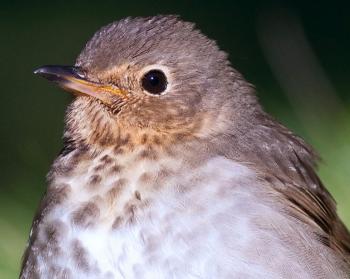Experience the Miracle of Night Migration
As we near the end of the spring migration period, we are still waiting for and hoping for one big night migration experience. It’s possible, even likely, that there was such a night here in Maine already and that we just missed it this year while due to family responsibilities—or Celtics playoff games! But we have been listening from the porch on quite a few nights without hearing the hoped-for concert of calls of a surge of night-migrating birds beating their wings through the night to get to their breeding grounds.
As younger birders we had been only vaguely aware of the phenomenon of night migration. We had heard stories of a few die-hard and expert birders reporting hearing dozens, sometimes even hundreds, of thrushes calling as they flew over at night. To us back then, that seemed like it must be some kind of rare event detected by only the world’s most accomplished bird identification experts. Little did we realize that the great majority of North American birds migrate at night; that those that migrate during the day, like swallows and hawks, are in the minority. That means literally hundreds of millions of birds move across the hemisphere every night during the spring and fall migration seasons.
It wasn’t until a few years after moving to Ithaca, New York, to attend graduate school at Cornell University that we first became aware that it is was regularly possible to experience night migration and eventually to even learn how to identify bird species by the short calls they give during night migration. An amazing, free-spirited ornithological adventurer and nocturnal flight call pioneer named Bill Evans was living in Ithaca at the time. Bill would spend his days working at the Cornell Lab of Ornithology’s Library of Natural Sounds, but his nights (at least during migration) were focused on recording and listening to the calls of nocturnally migrating birds.
Some years earlier Bill had stumbled upon night migration when, as a young college-aged birder living in Minnesota, he had been lying on a hill late at night contemplating life when he began hearing dozens of odd rattling calls overhead. Later, after doing some homework, he figured out that the birds were black-billed cuckoos.
This revelation, that birds migrated in great numbers at night and that it might be possible to identify them, set Bill on to a life long journey to figure out the many unknown calls that came raining down from the dark sky during migration. He had to play a patient and sometimes laboriously slow detective game to figure out which species gave which calls, since many of the night calls are different from the daytime calls. In the process, he put hundreds of thousands of miles on his old truck, driving to different parts of the country where he knew only one of several similar-sounding species would occur. He would record the sounds of nocturnal migrants in that area to compare to the sounds he had recorded from another area where only the other species could be found. Bill would also find places where birds would still be flying over at dawn, often coming in from an open ocean crossing to land, where he could visually identify them and record their calls at the same time. In the breeding season Bill would spend hours listening to and sound recording birds on their breeding territories where he discovered they would occasionally emit their night flight calls as well.
Bill eventually ended up in Ithaca at the Cornell Lab of Ornithology and he occasionally would invite people to come up and listen with him on a local high promontory called Mount Pleasant. We were among many that got to meet Bill during that time and spend time starting to learn to identify the calls of night-migrating birds. And we have been listening and learning and marveling at the miracle of night migration ever since!
In these last days of May and the first week or so of June, there will still be migrant birds passing over our heads each night. One of the easiest to hear and identify during that period is the Swainson’s thrush. These birds, just slightly smaller than a robin, are on their way to an extensive breeding range that extends from northern Maine across Canada to Alaska. As they fly over at night, hundreds of feet up, listen for their distinctive “heep” call, sounding remarkably like the call of the tiny spring peeper frogs that we hear in ponds and other wetlands.
We hope you can get out and listen and have your own night migration experience!
Jeffrey V. Wells, Ph.D., is a Fellow of the Cornell Lab of Ornithology. Dr. Wells is one of the nation's leading bird experts and conservation biologists and author of the “Birder’s Conservation Handbook.” His grandfather, the late John Chase, was a columnist for the Boothbay Register for many years. Allison Childs Wells, formerly of the Cornell Lab of Ornithology, is a senior director at the Natural Resources Council of Maine, a nonprofit membership organization working statewide to protect the nature of Maine. Both are widely published natural history writers and are the authors of the popular book, “Maine’s Favorite Birds” (Tilbury House) and the newly released “Birds of Aruba, Bonaire, and Curaçao” from Cornell University Press.





























